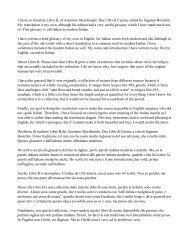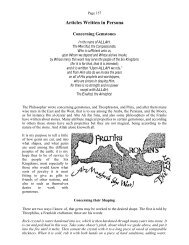How to Milk an Almond Stuff an Egg And Armor a Turnip A ...
How to Milk an Almond Stuff an Egg And Armor a Turnip A ...
How to Milk an Almond Stuff an Egg And Armor a Turnip A ...
You also want an ePaper? Increase the reach of your titles
YUMPU automatically turns print PDFs into web optimized ePapers that Google loves.
155<br />
An Islamic Dinner<br />
Islamic feasts in the Society are only occasionally cooked from recipes from period sources;<br />
yet Islam was a literate culture early in our period, with the result that there are a number of<br />
surviving cookbooks from the 10th <strong>to</strong> the 15th century. My lord Cariadoc <strong>an</strong>d I have been<br />
cooking from the cookbooks available in English for some years <strong>an</strong>d now have a large s<strong>to</strong>ck of<br />
tested Islamic recipes, so I decided <strong>to</strong> cook a dinner for the Grey Gargoyles’ Spring Tournament<br />
completely from medieval Islamic recipes. I had three objectives in designing the menu, in<br />
addition <strong>to</strong> making a good dinner that my friends would enjoy: I w<strong>an</strong>ted <strong>to</strong> show something of the<br />
r<strong>an</strong>ge of medieval Islamic food; I w<strong>an</strong>ted <strong>to</strong> make it a very low-work feast, so that more of us<br />
could enjoy the <strong>to</strong>urney; <strong>an</strong>d I w<strong>an</strong>ted <strong>to</strong> reduce the cost as much as possible. Other<br />
considerations included bal<strong>an</strong>ce of flavors, allowing for allergies, <strong>an</strong>d limited kitchen space.<br />
Menu<br />
There are a number of recipes for relishes or dips in the period Islamic cookbooks. The feast<br />
started with one of these, Badinj<strong>an</strong> Muhassa (p. 111), served with bread. Unfortunately, I knew<br />
very little about medieval Islamic bread other th<strong>an</strong> the fact that it existed, but I assumed that<br />
modern pita bread would be a reasonable guess. Badinj<strong>an</strong> Muhassa is based on eggpl<strong>an</strong>t, ground<br />
<strong>an</strong>d <strong>to</strong>asted walnut, <strong>an</strong>d raw onion; eggpl<strong>an</strong>t is probably the most common vegetable in medieval<br />
Islamic cookbooks. This version of the recipe is from a 10th century collection; <strong>an</strong>other version is<br />
in the 13th-century cookbook of al-Bagdadi.<br />
The main course consisted of Tabâhajah from the m<strong>an</strong>uscript of Yahya b. Khalid (p. 97), a<br />
Cooked Dish of Lentils (p. 99), <strong>an</strong>d <strong>And</strong>alusi<strong>an</strong> Chicken (p. 77), served with rice. The Tabâhajah<br />
is from <strong>an</strong>other of the cookbooks in the 10th-century collection. It is one of those rare period<br />
recipes which gives exact qu<strong>an</strong>tities for most of the ingredients. It consists of meat (we used<br />
lamb) marinated, cooked in oil, <strong>an</strong>d <strong>to</strong>pped with chopped greens. The marinade is based on murri,<br />
a condiment widely used in medieval Islamic cooking. Real murri was made by a lengthy process<br />
involving fermentation; so far as we know it has not been used since the 15th century. <strong>How</strong>ever,<br />
there exists a period recipe for quick <strong>an</strong>d cheap imitation murri, <strong>an</strong>d we made up a supply of that<br />
for the marinade. Judging by comments, <strong>an</strong>d by how little was left over, the Tabâhajah was the<br />
real hit of the feast.<br />
The Cooked Dish of Lentils consists of lentils cooked with onions <strong>an</strong>d spices, with eggs<br />
cooked on <strong>to</strong>p at the end. It is one of the easiest dishes I know of, the only real work being<br />
chopping the onions, <strong>an</strong>d is a favorite with our after fighter practice crowd. It also provides a<br />
main dish for vegetari<strong>an</strong>s (at least those who eat eggs <strong>an</strong>d dairy products). Both this <strong>an</strong>d the<br />
<strong>And</strong>alusi<strong>an</strong> Chicken are from <strong>an</strong> <strong>And</strong>alusi<strong>an</strong> (Moorish Sp<strong>an</strong>ish) cookbook of the 13th century by<br />
al-<strong>And</strong>alusi.<br />
The original title on the recipe for <strong>And</strong>alusi<strong>an</strong> Chicken was just “Another Dish,” so I gave it a<br />
more descriptive name. It is made by frying the chicken with oil <strong>an</strong>d some seasonings “until it is<br />
gilded,” simmering it in the juice of onion <strong>an</strong>d green cori<strong>an</strong>der (cil<strong>an</strong>tro), <strong>an</strong>d finally thickening<br />
the sauce with breadcrumb <strong>an</strong>d egg.<br />
Of the three main dishes, the lentil dish has neither meat nor wheat, the Tabâhajah has neither<br />
eggs nor dairy products, <strong>an</strong>d the chicken has neither onions nor dairy products, so that someone<br />
with <strong>an</strong>y single one of these common food allergies would be able <strong>to</strong> eat at least one dish. With<br />
only three main dishes, I could not allow for multiple allergies. In order that our guests could find<br />
out what was in the food, the servers, both kitchens, <strong>an</strong>d the au<strong>to</strong>crat were provided with a list of<br />
all ingredients in each dish, including drinks <strong>an</strong>d desserts.





